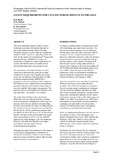JavaScript is disabled for your browser. Some features of this site may not work without it.
| dc.contributor.author | Hardy, Roger N. | |
| dc.contributor.author | Watson, J. W. | |
| dc.contributor.author | Kayvantash, K. | |
| dc.date.accessioned | 2012-01-05T15:34:00Z | |
| dc.date.available | 2012-01-05T15:34:00Z | |
| dc.date.issued | 2009-06 | |
| dc.identifier.citation | R. N. Hardy, J. W. Watson and K. Kayvantash, Safety requirements for cyclists during impacts to the legs, Proceedings of the 21st (ESV) International Technical Conference on the Enhanced Safety of Vehicles, June 2009, Stuttgart, Germany | en_UK |
| dc.identifier.uri | http://dspace.lib.cranfield.ac.uk/handle/1826/6832 | |
| dc.description.abstract | The term vulnerable road user (VRU) is most commonly associated with pedestrians and in particular children and the elderly. In many European countries cyclists make up a significant number of VRU casualties - typically around one third. In the context of the European 6th Framework Integrated Project APROSYS (Advance PROtection SYStems), a study was conducted to examine the safety requirements for cyclists and whether these were addressed by current pedestrian safety assessments of cars. An examination of accident statistics was first conducted to determine the principal accident scenarios for cyclists. Since insufficient cyclist cases were recorded in a detail database of VRU accidents compiled during APROSYS, a programme of virtual testing was then conducted. The objective was to identify the most significant parameters during cyclist impacts with a range of cars sizes and the likely injury consequences. The primary region of investigation was impacts to the legs and knees - the points of first contact. The study indicated that cyclists interacted differently with cars than pedestrians, resulting from the geometric configuration of their legs, the presence of the bicycle and their elevated riding position. The potential for injury was different and the current sub-system impactor tests used by Euro NCAP and for vehicle certification purposes did not address all these differences. It was determined that the relevance of the current pedestrian impact safety assessments of cars for cyclists could be improved by minor changes to the test parameters. However, the study also identified new injury mechanisms that may require further biomechanical investigations. Although this study has considered a wide range of cyclist impact configurations it should not be considered as definitive. Further work including physical testing is needed in order to take forward improved safety test procedures. | en_UK |
| dc.language.iso | en | en_UK |
| dc.publisher | National Highway Traffic Safety Administration | en_UK |
| dc.title | Safety requirements for cyclists during impacts to the legs | en_UK |
| dc.type | Conference paper | en_UK |
Files in this item
This item appears in the following Collection(s)
-
Staff publications (SAS) [907]
